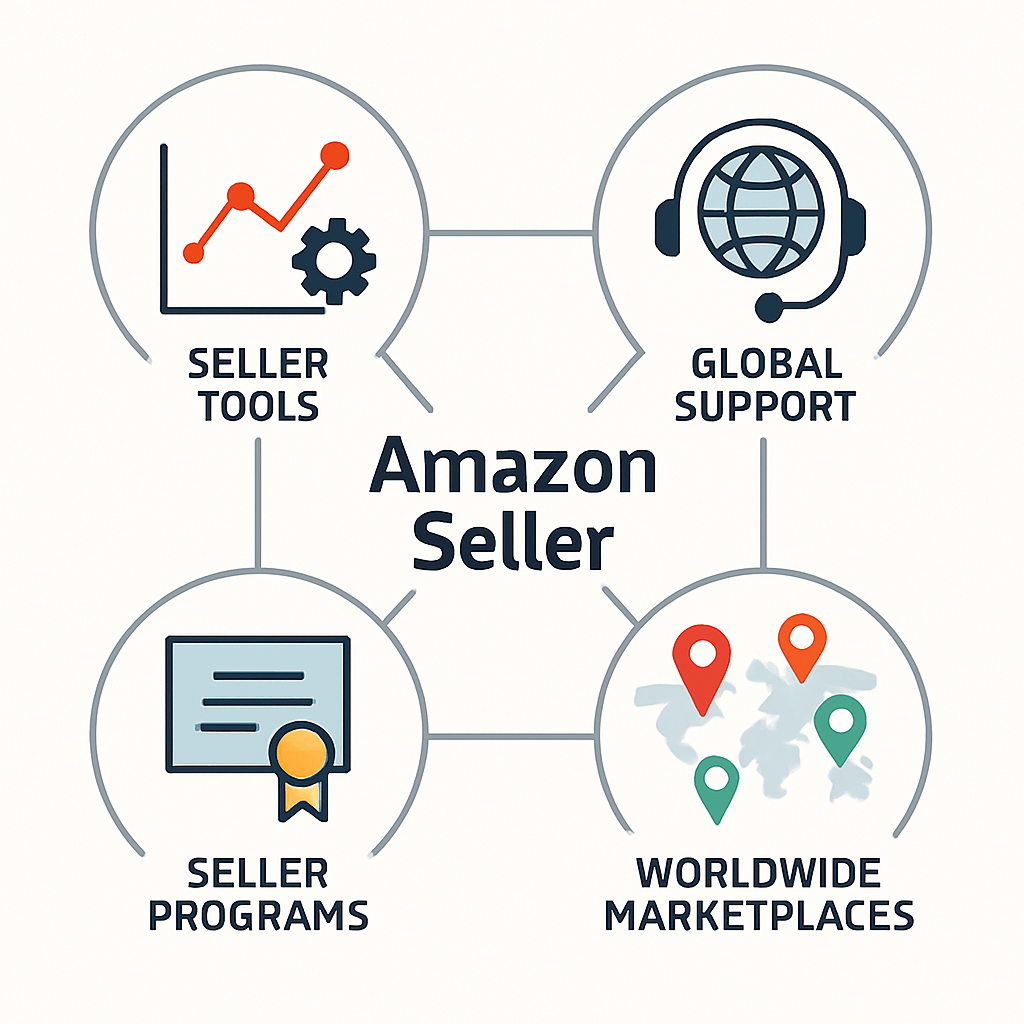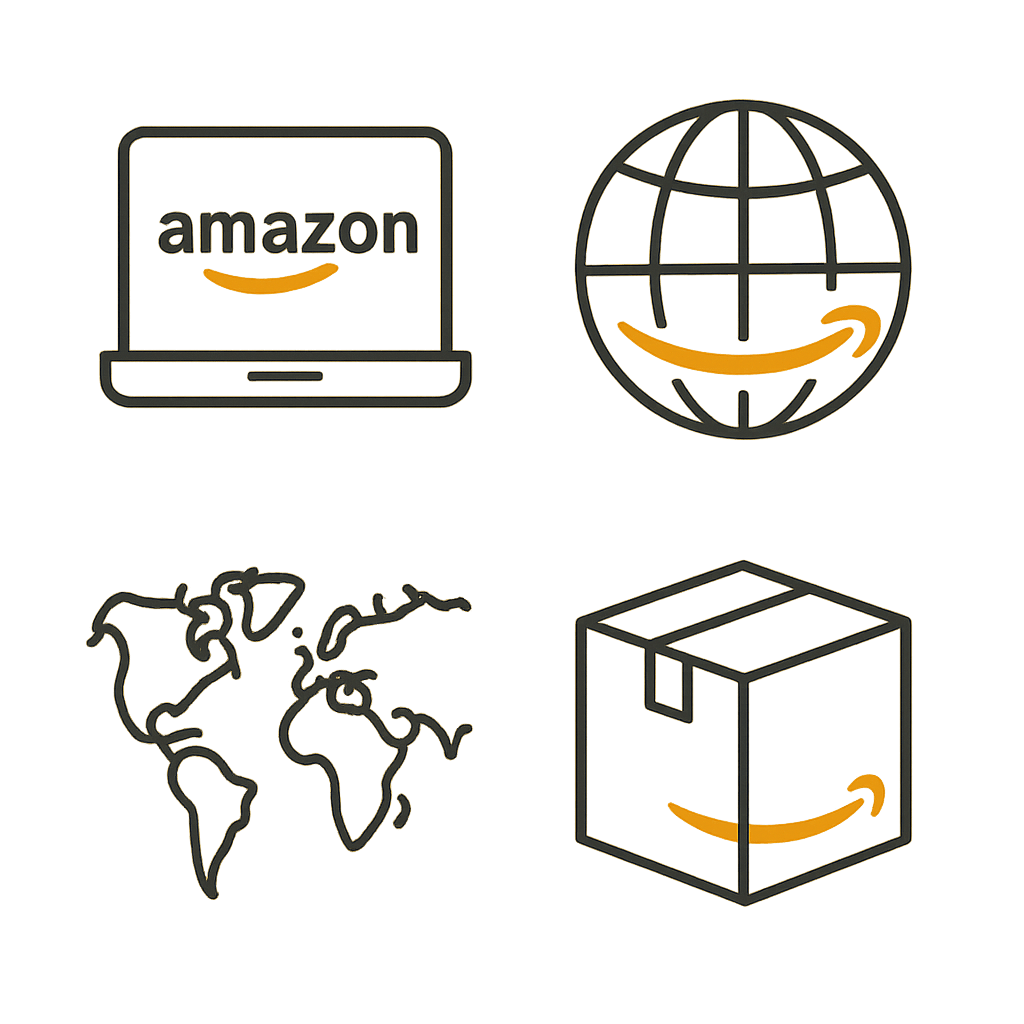Thinking of selling on Amazon beyond your home country?
Are you stuck on logistics, taxes, or translations? You’re not alone.
Expanding internationally can feel like stepping into a foreign country without a map — exciting, lucrative, and full of traps. Amazon Global Expansion Services are designed to flatten that learning curve and let you scale more confidently. This blog covers what Amazon’s international selling services include, the real benefits and risks, a step-by-step expansion blueprint, practical tips to succeed, and common pitfalls to avoid.
What are Amazon Global Expansion Services?
Amazon Global Expansion Services is an umbrella term for the suite of tools, seller programs, and support offerings Amazon provides to help businesses sell across Amazon global marketplaces worldwide.

Amazon helps manage or simplify the complex aspects of cross-border e-commerce — from translating product pages and calculating duties, to moving inventory and routing returns — so sellers can focus on their products, marketing, and customer experience.
These services are available to sellers of all sizes: individual entrepreneurs testing one market, mid-market brands building a multi-country presence, and enterprise sellers who want to orchestrate inventory and advertising across regions.
What will Amazon Global Selling give you?
- Access to new customers: Millions of international shoppers use Amazon global marketplaces every day. Entering one more country multiplies your potential audience.
- Built-in fulfillment and logistics: Amazon’s fulfillment networks (FBA) and cross-border shipping options reduce the operational burden of warehousing, picking, packing, and shipping internationally.
- Localized shopping experience: Amazon offers localized storefronts, payment methods, and customer service, ensuring your listings feel native to each market.
- Data and tools: Market insights, advertising platforms, and seller analytics help you adapt assortments, prices, and campaigns for each region.
- Trust and credibility: Amazon’s brand and A-to-z buyer protections reduce friction for customers buying from foreign sellers.
Key components of the Amazon Global Selling Program
Below are the common services and support layers Amazon provides to help sellers go global:
Marketplace onboarding and account setup
Amazon simplifies creating local seller accounts and linking them to your existing account where possible. This includes guidance on required documentation, verification, and seller policies for each country.
Listing translation and localization
Beyond literal translation, Amazon’s tools help localize product titles, bullets, and A+ content to meet local language, cultural expectations, and compliance with Amazon worldwide selling rules.
International shipping and fulfillment (FBA and Pan-EU / Pan-Amazon)
Amazon offers international FBA programs and cross-border FBA options, so you can either store inventory in local fulfillment centers or ship from your home country while Amazon handles final-mile delivery. Programs like Pan-EU (or regional equivalents) let inventory be distributed across multiple hubs to improve delivery speed and reduce fees.
Duties, taxes, and compliance support
Amazon provides calculators and guidance for VAT/GST registration, customs duties, and import taxes. They may offer tools to estimate landed cost, and in some regions, they collect and remit taxes at checkout (where legislatively allowed).
Currency conversion and international payments
Amazon handles local currency transactions and converts proceeds back to your selected payout currency. They also offer services to reduce foreign exchange friction.
Returns and customer service
Local return management and Amazon-handled customer service reduce the burden of managing returns and complaints across time zones and languages.
Advertising and marketing support
Access to localized advertising tools and campaigns (sponsored products, display, DSP) that reach shoppers in the target markets. Amazon also provides market data and trends to inform ad targeting.
Compliance & restricted product guidance
Support to check product restrictions, labelling rules, safety standards, and certification requirements by country. This reduces the risk of listings being blocked or inventory being held at customs.
How to sell globally on Amazon?
- Decide which markets to target
Use sales data, search volume, and competitor analysis to prioritize markets. Consider language, shipping times, tax regimes, and local demand. - Check product eligibility and compliance
Validate that your product can be sold in the target country. Check regulations for electronics, cosmetics, food, toys, medical items, and restricted materials. - Cost and profit modelling
Calculate landed costs: product cost, international shipping, customs duties, FBA fees, local taxes, and advertising. Only expand where margins remain healthy. - Localize listings
Translate and localize titles, bullets, descriptions, images, and A+ content. Local vernacular and measurement units (metric vs imperial) matter. - Choose a fulfillment strategy
Decide between shipping to FBA in the target country, using a pan-regional program, or fulfilling from your home country with cross-border shipping. - Set up taxes and bank details
Register for VAT/GST if required, configure Amazon tax settings, and set up payout and currency conversions. - Launch with local advertising
Run localized sponsored ads and promotions to build visibility. Use early customer reviews (compliant with Amazon rules) to boost credibility. - Monitor, iterate, and scale
Track conversion rates, returns, and ad efficiency. Adjust pricing, inventory distribution, and keywords per market performance.
Practical tips for success on Amazon FBA Global Expansion
- Start small and test: Launch one or two SKUs in a single new market to learn the ropes before a larger rollout.
- Localize visuals: Product images that resonate in one culture may not in another. Use regionally relevant imagery and consider local models.
- Beware of pricing parity and exchange rate shocks: Price products to account for fees and FX volatility. Keep a buffer for exchange and unexpected duty changes.
- Optimize for mobile: Many international shoppers browse and buy on mobile; make sure your content is scannable and fast to load.
- Use early reviewer programs ethically: Genuine customer feedback is gold — but follow Amazon worldwide selling policies strictly to avoid account issues.
- Inventory safety stock: International logistics can be slower; maintain a buffer stock to prevent OOS (out of stock) situations, which damages ranking.
- Leverage Amazon’s market data: Use available reports and search term data to refine your product mix and advertising.
Common pitfalls of selling internationally on Amazon and how to avoid them
- Underestimating total costs: Many sellers forget to include taxes, return shipping, customs clearance fees, and foreign bank fees in their margin calculations. It’s always wise to build a complete landed-cost model before launching.
- Poor localization: Bad translations or culturally inappropriate images can severely reduce conversion. We advise our clients to invest in professional localization, not just machine translation.
- Ignoring regulations: Noncompliant labelling or missing certifications can lead to listing removal or seized stock. It’s important to consult local compliance resources or third-party specialists for regulated categories.
- Overextending inventory: Sending large shipments to a new market without validated demand can trap capital. Start with conservative quantities and scale based on demand signals.
- Customer service gaps: Slow replies in the local language harm seller metrics and reviews. We advise sellers to use Amazon’s customer service options or hire multilingual support.
Is Amazon International Selling expensive?
In our experience of working with clients who sell internationally on Amazon or sell on Amazon global marketplaces, we’ve found that the cost of Amazon worldwide selling varies hugely. The major expense buckets are shipping & duties, local FBA fees, advertising to build visibility, and compliance/tax registration. Small sellers can start with limited investment if they choose cross-border fulfillment (ship on demand to Amazon) and focus on high-margin SKUs. Larger brands often allocate more to inventory and localized marketing to accelerate growth.
The smart approach is to model different scenarios (best/worst case), run a small pilot, and only scale after the pilot meets ROI targets you set.
A short hypothetical micro case study of the Amazon Global Selling Program
Imagine a handcrafted home decor brand in India that sells well domestically. They test the UK market with two bestselling items using Amazon’s UK marketplace and a cross-border FBA option. They localized listings for British English, shipped an initial small batch to a UK FBA center, and launched a modest Sponsored Products campaign. Within 90 days, they had steady daily sales, identified the best-selling SKU, and scaled inventory into a wider European pan-region program — all while iterating on pricing to account for VAT and return rates. The key lessons, therefore, are: test, localize, and watch metrics closely.
Is Amazon Global Expansion Services right for you?
If your product has universal appeal or a niche that’s in demand internationally, Amazon’s global toolkit can dramatically shorten your path to new customers. The platform removes many operational barriers but doesn’t eliminate the need for smart planning. Success depends on good product fit, careful cost modelling, localized marketing, and compliance diligence.
Start small, validate quickly, and use Amazon’s global expansion services to handle operational friction so you can focus on product, positioning, and growth strategy. With methodical testing and sensible risk management, international selling on Amazon can be a powerful engine for scaling your brand.
Need help with Amazon FBA Global Expansion? We have a special team dedicated to this area.

